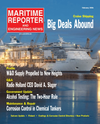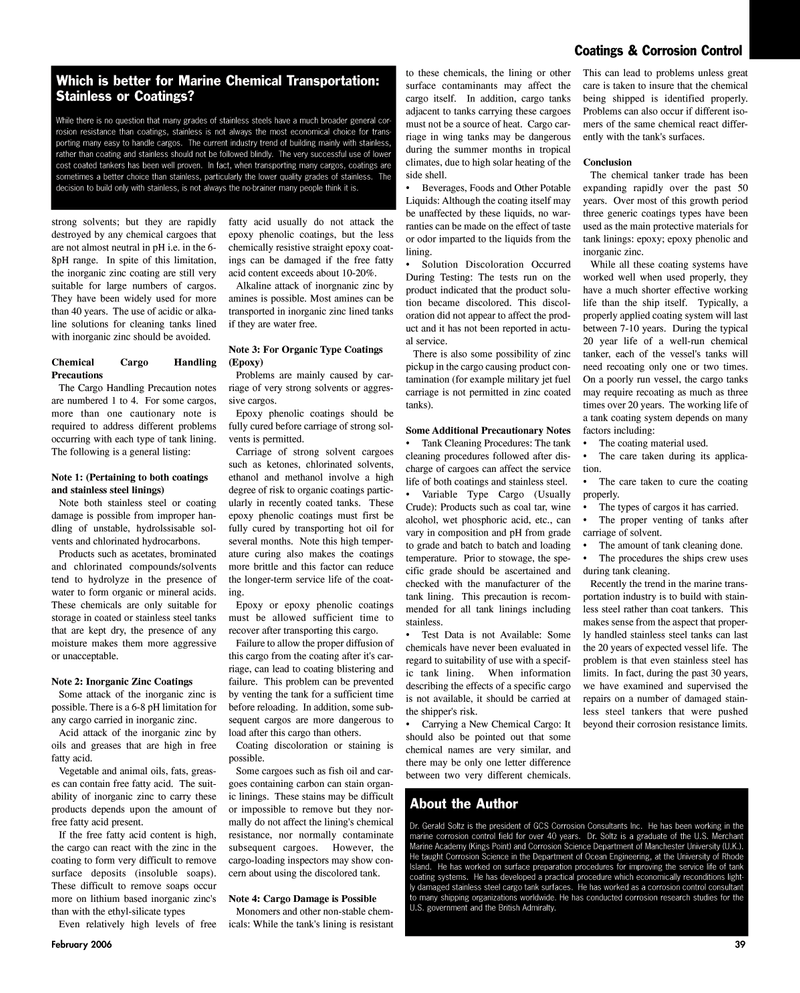
Page 39: of Maritime Reporter Magazine (February 2, 2006)
Read this page in Pdf, Flash or Html5 edition of February 2, 2006 Maritime Reporter Magazine
strong solvents; but they are rapidly destroyed by any chemical cargoes that are not almost neutral in pH i.e. in the 6- 8pH range. In spite of this limitation, the inorganic zinc coating are still very suitable for large numbers of cargos.
They have been widely used for more than 40 years. The use of acidic or alka- line solutions for cleaning tanks lined with inorganic zinc should be avoided.
Chemical Cargo Handling
Precautions
The Cargo Handling Precaution notes are numbered 1 to 4. For some cargos, more than one cautionary note is required to address different problems occurring with each type of tank lining.
The following is a general listing:
Note 1: (Pertaining to both coatings and stainless steel linings)
Note both stainless steel or coating damage is possible from improper han- dling of unstable, hydrolssisable sol- vents and chlorinated hydrocarbons.
Products such as acetates, brominated and chlorinated compounds/solvents tend to hydrolyze in the presence of water to form organic or mineral acids.
These chemicals are only suitable for storage in coated or stainless steel tanks that are kept dry, the presence of any moisture makes them more aggressive or unacceptable.
Note 2: Inorganic Zinc Coatings
Some attack of the inorganic zinc is possible. There is a 6-8 pH limitation for any cargo carried in inorganic zinc.
Acid attack of the inorganic zinc by oils and greases that are high in free fatty acid.
Vegetable and animal oils, fats, greas- es can contain free fatty acid. The suit- ability of inorganic zinc to carry these products depends upon the amount of free fatty acid present.
If the free fatty acid content is high, the cargo can react with the zinc in the coating to form very difficult to remove surface deposits (insoluble soaps).
These difficult to remove soaps occur more on lithium based inorganic zinc's than with the ethyl-silicate types
Even relatively high levels of free fatty acid usually do not attack the epoxy phenolic coatings, but the less chemically resistive straight epoxy coat- ings can be damaged if the free fatty acid content exceeds about 10-20%.
Alkaline attack of inorgnanic zinc by amines is possible. Most amines can be transported in inorganic zinc lined tanks if they are water free.
Note 3: For Organic Type Coatings (Epoxy)
Problems are mainly caused by car- riage of very strong solvents or aggres- sive cargos.
Epoxy phenolic coatings should be fully cured before carriage of strong sol- vents is permitted.
Carriage of strong solvent cargoes such as ketones, chlorinated solvents, ethanol and methanol involve a high degree of risk to organic coatings partic- ularly in recently coated tanks. These epoxy phenolic coatings must first be fully cured by transporting hot oil for several months. Note this high temper- ature curing also makes the coatings more brittle and this factor can reduce the longer-term service life of the coat- ing.
Epoxy or epoxy phenolic coatings must be allowed sufficient time to recover after transporting this cargo.
Failure to allow the proper diffusion of this cargo from the coating after it's car- riage, can lead to coating blistering and failure. This problem can be prevented by venting the tank for a sufficient time before reloading. In addition, some sub- sequent cargos are more dangerous to load after this cargo than others.
Coating discoloration or staining is possible.
Some cargoes such as fish oil and car- goes containing carbon can stain organ- ic linings. These stains may be difficult or impossible to remove but they nor- mally do not affect the lining's chemical resistance, nor normally contaminate subsequent cargoes. However, the cargo-loading inspectors may show con- cern about using the discolored tank.
Note 4: Cargo Damage is Possible
Monomers and other non-stable chem- icals: While the tank's lining is resistant to these chemicals, the lining or other surface contaminants may affect the cargo itself. In addition, cargo tanks adjacent to tanks carrying these cargoes must not be a source of heat. Cargo car- riage in wing tanks may be dangerous during the summer months in tropical climates, due to high solar heating of the side shell. • Beverages, Foods and Other Potable
Liquids: Although the coating itself may be unaffected by these liquids, no war- ranties can be made on the effect of taste or odor imparted to the liquids from the lining. Solution Discoloration Occurred
During Testing: The tests run on the product indicated that the product solu- tion became discolored. This discol- oration did not appear to affect the prod- uct and it has not been reported in actu- al service.
There is also some possibility of zinc pickup in the cargo causing product con- tamination (for example military jet fuel carriage is not permitted in zinc coated tanks).
Some Additional Precautionary Notes Tank Cleaning Procedures: The tank cleaning procedures followed after dis- charge of cargoes can affect the service life of both coatings and stainless steel. Variable Type Cargo (Usually
Crude): Products such as coal tar, wine alcohol, wet phosphoric acid, etc., can vary in composition and pH from grade to grade and batch to batch and loading temperature. Prior to stowage, the spe- cific grade should be ascertained and checked with the manufacturer of the tank lining. This precaution is recom- mended for all tank linings including stainless. Test Data is not Available: Some chemicals have never been evaluated in regard to suitability of use with a specif- ic tank lining. When information describing the effects of a specific cargo is not available, it should be carried at the shipper's risk. Carrying a New Chemical Cargo: It should also be pointed out that some chemical names are very similar, and there may be only one letter difference between two very different chemicals.
This can lead to problems unless great care is taken to insure that the chemical being shipped is identified properly.
Problems can also occur if different iso- mers of the same chemical react differ- ently with the tank's surfaces.
Conclusion
The chemical tanker trade has been expanding rapidly over the past 50 years. Over most of this growth period three generic coatings types have been used as the main protective materials for tank linings: epoxy; epoxy phenolic and inorganic zinc.
While all these coating systems have worked well when used properly, they have a much shorter effective working life than the ship itself. Typically, a properly applied coating system will last between 7-10 years. During the typical 20 year life of a well-run chemical tanker, each of the vessel's tanks will need recoating only one or two times.
On a poorly run vessel, the cargo tanks may require recoating as much as three times over 20 years. The working life of a tank coating system depends on many factors including: The coating material used. The care taken during its applica- tion. The care taken to cure the coating properly. The types of cargos it has carried. The proper venting of tanks after carriage of solvent. The amount of tank cleaning done. The procedures the ships crew uses during tank cleaning.
Recently the trend in the marine trans- portation industry is to build with stain- less steel rather than coat tankers. This makes sense from the aspect that proper- ly handled stainless steel tanks can last the 20 years of expected vessel life. The problem is that even stainless steel has limits. In fact, during the past 30 years, we have examined and supervised the repairs on a number of damaged stain- less steel tankers that were pushed beyond their corrosion resistance limits.
Coatings & Corrosion Control
About the Author
Dr. Gerald Soltz is the president of GCS Corrosion Consultants Inc. He has been working in the marine corrosion control field for over 40 years. Dr. Soltz is a graduate of the U.S. Merchant
Marine Academy (Kings Point) and Corrosion Science Department of Manchester University (U.K.).
He taught Corrosion Science in the Department of Ocean Engineering, at the University of Rhode
Island. He has worked on surface preparation procedures for improving the service life of tank coating systems. He has developed a practical procedure which economically reconditions light- ly damaged stainless steel cargo tank surfaces. He has worked as a corrosion control consultant to many shipping organizations worldwide. He has conducted corrosion research studies for the
U.S. government and the British Admiralty.
February 2006 39
Which is better for Marine Chemical Transportation:
Stainless or Coatings?
While there is no question that many grades of stainless steels have a much broader general cor- rosion resistance than coatings, stainless is not always the most economical choice for trans- porting many easy to handle cargos. The current industry trend of building mainly with stainless, rather than coating and stainless should not be followed blindly. The very successful use of lower cost coated tankers has been well proven. In fact, when transporting many cargos, coatings are sometimes a better choice than stainless, particularly the lower quality grades of stainless. The decision to build only with stainless, is not always the no-brainer many people think it is.
MR FEBRUARY2006 #5 (33-40).qxd 2/1/2006 7:57 PM Page 39

 38
38

 40
40
